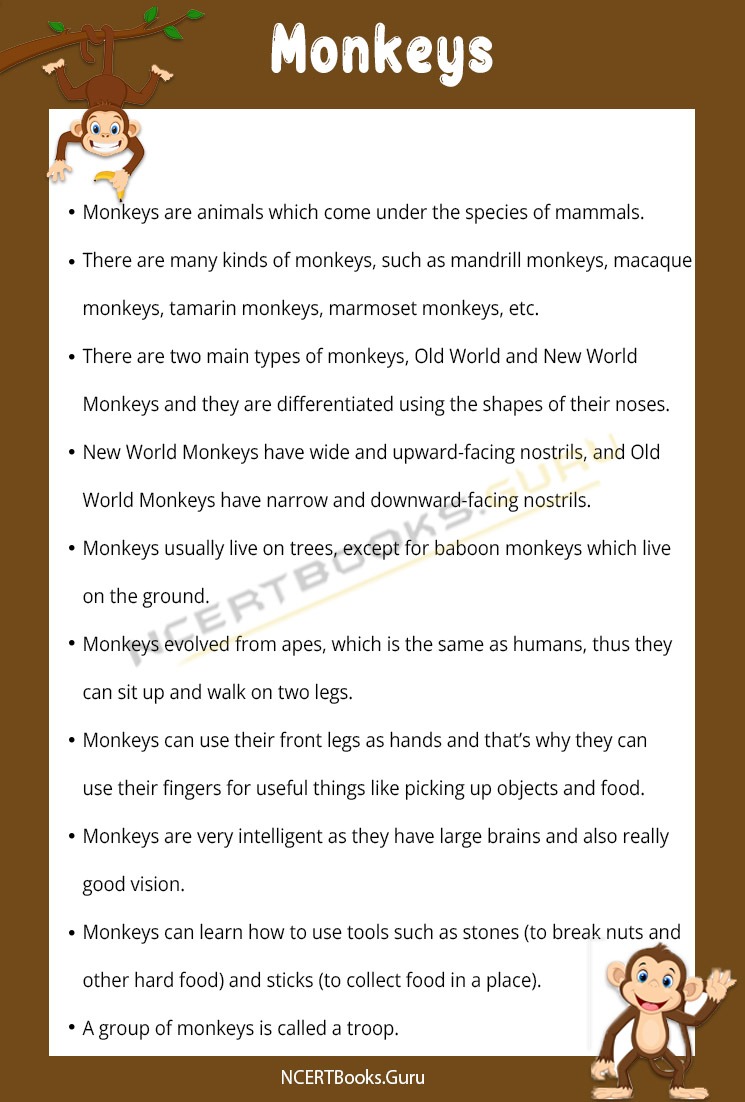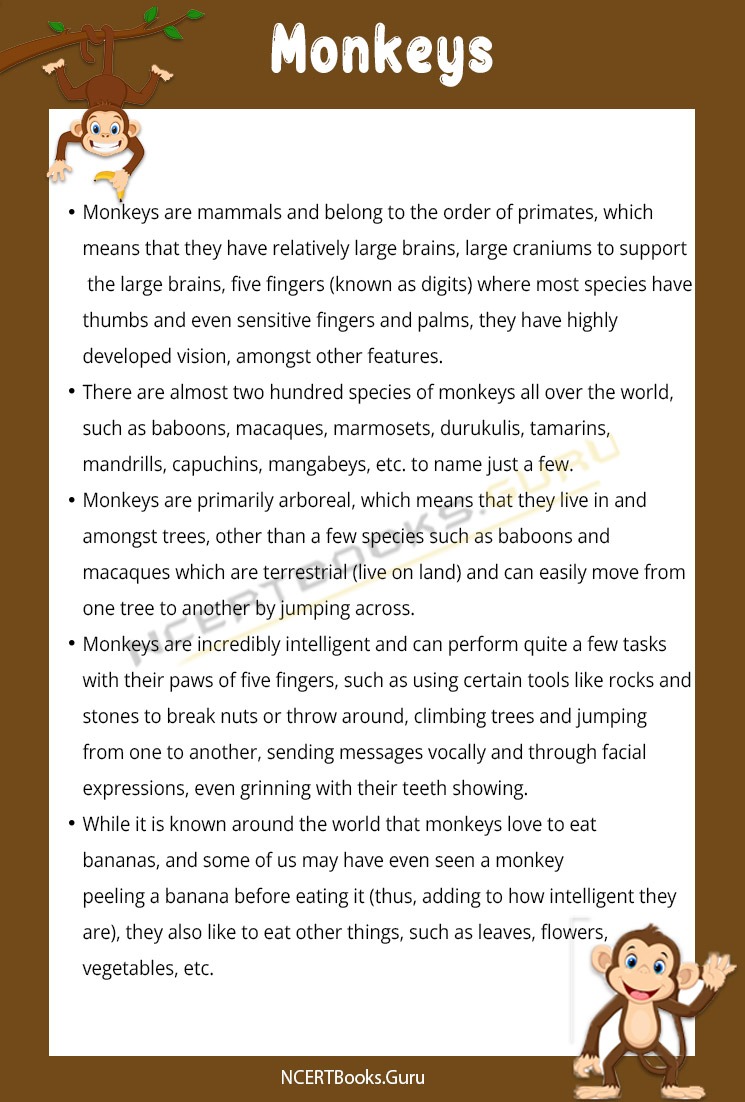10 Lines on Monkeys: Monkeys are primates and mammals and there are almost 200 hundred species of monkeys around the world. Some species include macaques, mandrills, bonobos, tamarins, sakis, marmosets, etc.
Monkeys can be broadly divided into Old World Monkeys and New World Monkeys, and the distinctions can be seen in the physical traits of the monkeys. Old World Monkeys have narrower noses while New World Monkeys have wider noses. Old World Monkeys also have cheek pouches where they can store food when they’re on the run to eat later, and they also have rump pads which they can sit on.
Monkeys are incredibly intelligent and have great fine motor skills which they can use to pick up stones and use them to break nuts, even throw them at people, and most of us are aware of the fact that monkeys can peel bananas before eating them. Below, there are three sets of 10 lines on monkeys which will be useful for students who are looking to write essays or write assignments about monkeys.
Enhance your vocabulary and writing skills with 10 Lines Essays available. Spark up the creativity in you and access various Topics on 10 Lines all in one place.
Set 1 – 10 Lines on Monkeys for kids
The following set of 10 lines on monkeys will be useful for students and children who are in classes 1, 2, 3, 4 and 5.
- Monkeys are animals which come under the species of mammals.
- There are many kinds of monkeys, such as mandrill monkeys, macaque monkeys, tamarin monkeys, marmoset monkeys, etc.
- There are two main types of monkeys, Old World and New World Monkeys and they are differentiated using the shapes of their noses.
- New World Monkeys have wide and upward-facing nostrils, and Old World Monkeys have narrow and downward-facing nostrils.
- Monkeys usually live on trees, except for baboon monkeys which live on the ground.
- Monkeys evolved from apes, which is the same as humans, thus they can sit up and walk on two legs.
- Monkeys can use their front legs as hands and that’s why they can use their fingers for useful things like picking up objects and food.
- Monkeys are very intelligent as they have large brains and also really good vision.
- Monkeys can learn how to use tools such as stones (to break nuts and other hard food) and sticks (to collect food in a place).
- A group of monkeys is called a troop.

Set 2 – 10 Lines on Monkeys for School Children
The following set of 10 lines on monkeys will be useful for students who are in classes 6, 7, 8 and 9.
- Monkeys belong to the animal group of primates and they are classified as mammals, meaning that they give birth to their young rather than laying eggs.
- Monkeys have four limbs which they use to walk, but they can also stand up, sit up and even walk on only their two back limbs.
- There are almost 200 different species of monkeys, including but not limited to mandrills, macaques, baboons, langurs, durukulis, marmosets, tamarins, sakis, capuchins, etc.
- Monkeys can be broadly classified into two kinds, namely Old World Monkeys and New World Monkeys, and it is mostly the shape of their noses through which we differentiate them.
- New World Monkeys are called “flat-nosed” in Latin, and they have broad noses and nostrils which face outwards.
- Old World Monkeys are called “downward-nosed” in Latin, and they have narrower noses with nostrils facing downwards, similar to humans, alongside what resembles seating pads on their rumps.
- Monkeys are incredibly intelligent creatures owing to their large brains, highly developed visions and their ability to use their fingers to create tools for themselves.
- A group of monkeys is called a troop and the female monkeys in the troop are generally much closer to one another than the male.
- Male monkeys leave their troops upon reaching maturity, while the female monkeys consistently remain in the same troop throughout their lives.
- While monkeys are very similar biologically, there are several variations of habits, appearances, practices, etc. between different species.
Set 3 – 10 Lines on Monkeys for Higher Class Students
The following set of 10 lines on monkeys will be useful for students who are in classes 10, 11 and 12.
- Monkeys are mammals and belong to the order of primates, which means that they have relatively large brains, large craniums to support the large brains, five fingers (known as digits) where most species have thumbs and even sensitive fingers and palms, they have highly developed vision, amongst other features.
- There are almost two hundred species of monkeys all over the world, such as baboons, macaques, marmosets, durukulis, tamarins, mandrills, capuchins, mangabeys, etc. to name just a few.
- Monkeys are primarily arboreal, which means that they live in and amongst trees, other than a few species such as baboons and macaques which are terrestrial (live on land) and can easily move from one tree to another by jumping across.
- Monkeys are incredibly intelligent and can perform quite a few tasks with their paws of five fingers, such as using certain tools like rocks and stones to break nuts or throw around, climbing trees and jumping from one to another, sending messages vocally and through facial expressions, even grinning with their teeth showing.
- While it is known around the world that monkeys love to eat bananas, and some of us may have even seen a monkey peeling a banana before eating it (thus, adding to how intelligent they are), they also like to eat other things, such as leaves, flowers, vegetables, etc.
- A group of monkeys is called a troop and can consist of a few members, male as well as female, or even close to a thousand, but the number of monkeys in a single troop varies according to the species of the monkey at which we are looking.
- Within very large troops, monkeys may even form sub-groups called harems, where there are a single male member, several female members and the offsprings produced by the group.
- Monkeys can be categorically divided into two broad kinds; New World Monkeys have wide nostrils facing upwards, and have rather long tails capable of catching things with them or hanging from them; Old World Monkeys have narrower, downward-facing noses, and they also have cheek pouches inside their mouths to store food for longer, and they also have sitting pads on their rumps (backside).
- The character Rafiki in the animated film series The Lion King is one of the most famous monkeys in the world, and while he is referred to as a baboon in the films, the species of monkeys he belongs to is actually mandrill.
- In India, the most commonly seen monkeys are langurs and the various species of macaque monkeys, including the rhesus macaque, bonnet macaque, Assam macaque, Arunachal macaque, stump-tailed macaque, lion-tailed macaque and the pig-tailed macaque.

Frequently Asked Questions on Monkeys
Question 1.
How many species of monkeys are there?
Answer:
There are almost 20 species of monkeys all across the world. To be precise, there are 196 species of monkeys around the world.
Question 2.
Are monkeys mammals?
Answer:
Yes, monkeys are mammals, which means that they give birth to their young rather than lay eggs.
Question 3.
Which are the species of monkeys most commonly found in India?
Answer:
- Macaques (rhesus, bonnet, Assam macaque, Arunachal macaque, stump-tailed, lion-tailed, pig-tailed, white-cheeked,)
- Langurs (black-footed grey langur, tufted grey langur, Kashmir grey langur, Tarai grey langur, Northern Plains and Southern Plains grey langur, golden langur, Nilgiri langur, capped langur, etc)
- Phayre’s Leaf Monkey
- Hoolock Gibbons, also the only species of apes in India.
Question 4.
Do monkeys really eat bananas?
Answer:
It’s true that monkeys eat bananas, in the same way that they would eat other fruits and vegetables. Monkeys in the wild do not go seeking bananas in the wild, but if they do get it, they’ll eat it just as they would an apple or strawberry. Bananas are certainly not as much of a favourite of monkeys as television and film tell us they are. However, feeding bananas to a monkey is not advisable, as the bananas we get in the markets are sweetened for human likingness and that level of sugar is not good for them.
